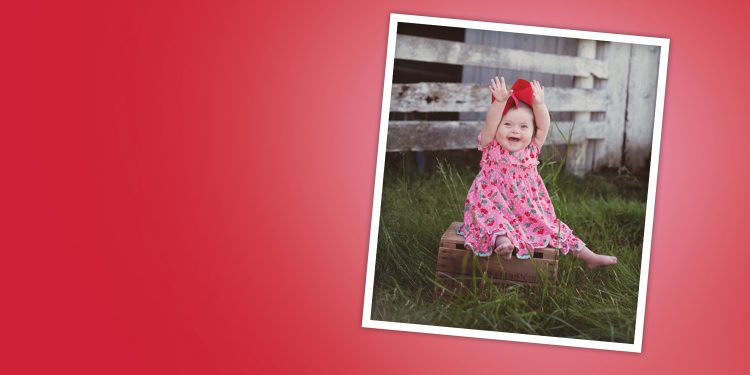When Cindy Wimsatt and John Maurice found out their daughter had Down Syndrome during the second trimester of Cindy’s pregnancy, the couple was shocked and very unprepared to hear the diagnosis. After two previous miscarriages, Cindy’s pregnancy was already considered high-risk. At 13 weeks her doctor performed a blood test to determine gender and identify any chromosome abnormalities. Cindy was thrilled that a simple blood test could tell her the gender of her baby in 4 – 6 weeks as the ultrasound indicated there were no concerns for any abnormalities. But the phone call from the doctor came with both a gender result – a girl – and 99% certainty that Cindy’s daughter had Down Syndrome.
“As parents you go through a roller coaster of emotions and its indescribable,” Cindy said. “Don’t get me wrong, I had a lot of concerns and at the same time I was thrilled to still have her growing inside me!”
But this wasn’t the only news Cindy and John would learn about their daughter. At their next appointment the couple learned Anna Sue also had a heart defect. A referral appointment with a cardiologist confirmed the unborn child had a heart defect called AVSD. But again, this wasn’t the only news Cindy and John would learn about Anna Sue. At a follow up appointment the doctor informed them that he suspected Anna Sue had TEF/Esophageal Artesia, a complication where the esophagus does not connect to the stomach.
“He had never diagnosed this before in this 20+ years of practice,” Cindy said. “So as parents we were now more concerned with her health issues and needed reassurance she was going to be OK.”
Despite the repeated bad news from doctors, Cindy says this wasn’t the worst part of Anna Sue’s diagnoses. “The hardest part about receiving the diagnosis of Down Syndrome was that I was repeatedly asked if I wanted to continue the pregnancy,” Cindy said. She later learned that doctors are required to give her alternative options until she was far enough into her pregnancy.
Cindy delivered Anna Sue at 37.5 weeks gestation by C-section at Norton’s Women’s Hospital. Anna Sue was immediately transferred to Kosairs and underwent surgery the next day to place a tube because of her detached esophagus. This was just the beginning of Anna Sue’s journey. At two months old she had an 8-hour open-heart surgery to repair her heart defect, which meant a 28-day hospital stay. At 11 months old she began the first of three surgeries to correct her esophagus at Boston Children’s Hospital. In all, Anna Sue has had 9 surgeries (about 60 hours of operating time) and 30 esophagus dilations.
Despite the potentially traumatic experiences Anna Sue has been dealt in her two short years, her mom, Cindy, says she is strong and determined.
“She has a smile that will melt your heart and a personality that will enlighten your day and she reassures me that everything is going to be OK,” Cindy said.
Something that has made dark days a little lighter for Anna Sue and her family is Green River Area Downs Syndrome Association (GRADSA), a charitable organization composed of families, friends and individuals who are interested in improving the lives of people with Down syndrome. Serving ten counties around the Green River region of Western Kentucky, GRADSA reaches out to nearly 150 families of infants, children and adults with Down syndrome who are seeking information, support and fellowship from people with this common interest.
Cindy was referred to GRADSA upon Anna Sue’s DS diagnosis. “I was greeted with a home visit from a mother and daughter with Down Syndrome and I was given a bag with gifts, information and books about children with Down Syndrome which was very comforting and reassuring for me,” Cindy said. “The organization is very important to me and our community as they provide us the resources and connections with other families with individuals with Down Syndrome. GRADSA also adds reasons to celebrate individuals like Anna Sue and help bring awareness to the community that children with Down Syndrome are more alike than different!”
The biggest celebration GRADSA holds is their annual Buddy Walk. Now in its 19th year locally, the Buddy Walk is a way to promote acceptance and inclusion of people with Down Syndrome. People with Down Syndrome, families and friends will walk a short route around McConnell Plaza and there will also be entertainment, games and bouncy houses and many other family oriented activities. A small portion of funds raised go to the National Down Syndrome Society for research and advocacy. A majority of the funds will be used in this community.
Renea Estes, GRADSA Board Member and Fundraising Chair, says she expects over 1,000 people to participate in the Buddy Walk this year. “It is unlike most walks you have been too,” Renea said. Renea has been involved with GRADSA since 2010 when she and her family relocated from Bowling Green. “I like to say it is more like a family reunion. I tell my family you can miss Chapel’s birthday party but you cannot miss the Buddy Walk.”
Most importantly, Renea believes that the Buddy Walk is a reminder of what gifts individuals with Down Syndrome bring to the community. “It is a way that the community can show their support and acceptance to the individuals with Down Syndrome and their families,” Renea said. “It also shows to the community that these individuals are more alike than different. Together, with the help of the community we can build a stronger community for individuals with Down Syndrome.”
The Buddy Walk will take place on September 24 at McConnell Plaza. Registration begins at 10:30 a.m. If you would like to register, join a team, build your own team, sponsor, or volunteer for Buddy Walk, please go to GRADSA.org to find more information.










